Motor vehicle
| Nissan Caravan | |
|---|---|
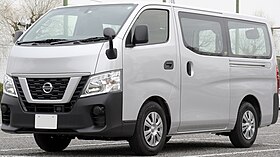 Nissan NV350 Caravan DX with dual sliding door (Japan) Nissan NV350 Caravan DX with dual sliding door (Japan) | |
| Overview | |
| Manufacturer | Nissan |
| Also called | Nissan Urvan |
| Production | 1965–1997 (Nissan Homy) 1973–present (Nissan Caravan) |
| Body and chassis | |
| Class | Light commercial vehicle |
| Body style | 4/5-door van |
| Layout |
|
| Chronology | |
| Predecessor | Nissan Caball (cargo/passenger van) Isuzu Fargo (Isuzu models) Nissan NV (North America) Mitsubishi Delica Cargo (Mitsubishi models) |
The Nissan Caravan is a light commercial van designed for use as a fleet vehicle or cargo van and manufactured by Nissan since 1973. Between 1976 and 1997, a rebadged version of the Caravan sold as the Nissan Homy, which was introduced as an independent model in 1965. Outside Japan, the Caravan was also sold as either the Nissan Urvan or Nissan King Van, or earlier with Datsun badging.
Prior to 1973, the Caravan's twin, the Homy, had been offered as a standalone generation from 1965 until 1976. The Homy was built and sold by the Prince Motor Company before the merger of Nissan in 1965 and the Homy was the first vehicle to be acquired by Nissan. After the merger in August 1966, because Nissan didn't have a large passenger platform, the Prince Homy was "badge engineered" as the Caravan, and the brand name was changed from Prince to Nissan. The merger was complete by 1970. It shared a chassis with the Prince Homer, a medium-duty cabover pickup truck.
The second generation Homy of 1976, was marketed as a twin to the 1973-era Nissan Caravan, sold at the Nissan Prince Store dealerships, while the Caravan was exclusive to Nissan Store locations. The first generation series B640 which was changed to Nissan series T20 was built from 1965 to 1976, the second generation E20 was built from 1976 to 1980, and the third generation E23 was built from 1980 to 1986. The final generation E24 was built from 1986 to 1999, and replaced by the Nissan Elgrand.
Mechanically, the Nissan Caravan and the Nissan Homy were identical. Its traditional competitor from Toyota is the HiAce. All generations use a cabover approach to maximize interior space while remaining within defined exterior dimensions.
Nissan's largest passenger van (or minibus) is the Nissan Civilian, introduced in 1959, and their smaller platform was the Nissan Vanette.
Predecessor (1965–1973)
Motor vehicle| Homer | |
|---|---|
 First generation Nissan Prince Homy (Thailand), sold as Nissan Homer First generation Nissan Prince Homy (Thailand), sold as Nissan Homer | |
| Overview | |
| Model code | B640 |
| Production | October 1965 – February 1973 |
| Powertrain | |
| Engine | 1.6 L OHV I4 |
| Dimensions | |
| Wheelbase | 2,130 mm (83.9 in) |
| Length | 4,325 mm (170.3 in) |
| Width | 1,690 mm (66.5 in) |
| Height | 1,900 mm (74.8 in) |
| Curb weight | 1,190 kg (2,624 lb) |
The Prince Homy (B640) was the passenger van version of the Prince Homer light duty truck, and had a seating capacity of up to 15 people. In 1966 as the Prince-Nissan merger began, it was initially called the Nissan Homy Prince, sharing load carrying duties with the Prince Skyway, and Prince Gloria station wagons; the Prince name became a dealership network within the Nissan organization in 1970. The Nissan Homy received the T20 model code, and in 1972, the vehicle was reclassified as a commercial vehicle, in order to comply with the 1970 Japanese road traffic law.
Nissan had integrated a previously built product called the Nissan Caball as a cabover truck and cargo van, but had replaced it with the Homy.
First generation (E20, E21, E22); (1973)
Motor vehicle| Caravan (E20) | |
|---|---|
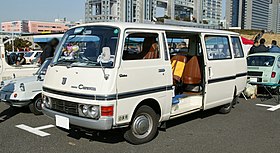 | |
| Overview | |
| Also called | Datsun Urvan Nissan Homy |
| Production | March 1973 – July 1980 |
| Powertrain | |
| Engine | |
| Dimensions | |
| Wheelbase | 2,350 mm (92.5 in) |
| Length | 4,690 mm (184.6 in) |
| Width | 1,690 mm (66.5 in) |
| Height | 1,905 mm (75.0 in) |
| Curb weight | 1,425 kg (3,142 lb) |
 Nissan Caravan (E20)
Nissan Caravan (E20)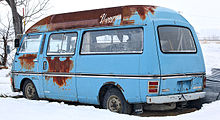 Nissan Homy (E20)
Nissan Homy (E20)
The E20 series Caravan and Urvan van and minibus were manufactured from February 1973 with seating configurations for three, five, seven, and up to 10 passengers. It was exclusive in Japan to Nissan Store, while its twin the Nissan Homy was exclusive to Nissan Prince Store locations. It was especially popular in Europe, and was again very popular with fire departments and as ambulances in certain countries. It had a somewhat difficult handling, as it was heavy to steer, and was not available with power steering. Also, the gear shifter was located at the floor and went all the way up to the height of the hand, and had a slight curve. The gear shifter was nearly 80 cm (2.6 ft) long, so it was somewhat clumsy to shift, but it came with five gears, unusual in Europe at that time.
It was delivered with a 1.5- and 2.0-liter petrol engines, as well as a 2.2-liter diesel unit. It was produced until replaced by the E23 Caravan in August 1980. In export markets the first and second generations were called Datsun Urvan, until the Nissan brand replaced it worldwide in 1983 and 1984. In 1978, Nissan added the smaller Vanette as the Caravan grew in dimensions and market positioning.
In South Africa the second generation E20 was made all the way to 1996 with 77,000 units sold, it received a few upgrades including redesigned bumpers from 1984 and square headlights, 5-speed gearbox and the H20 engine was replaced by an L18 motor with twin Hitachi carburetors from 1981 till final production in 1996.
- Nissan Homy
The second generation Homy was a rebadged Caravan sold through Nissan Prince Stores; there were no mechanical differences between the two.
Second generation (E23; 1980)
Motor vehicle| Caravan (E23) | |
|---|---|
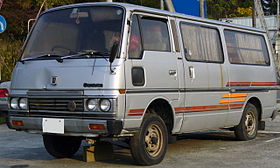 Nissan Caravan (E23) LWB Nissan Caravan (E23) LWB | |
| Overview | |
| Also called |
|
| Production | August 1980 – July 1986 |
| Body and chassis | |
| Related | Nissan Atlas Nissan Cabstar FAW Jiefang CA 6440 (1994–2000) |
| Powertrain | |
| Engine | |
| Dimensions | |
| Wheelbase |
|
| Length |
|
| Width | 1,690 mm (66.5 in) |
| Height | 1,950 mm (76.8 in) |
| Curb weight | 1,930 kg (4,255 lb) |

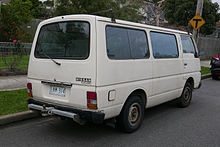 1985 Nissan Urvan (E23) SWB (Australia)
1985 Nissan Urvan (E23) SWB (Australia) Nissan Homy (E23) LWB
Nissan Homy (E23) LWB
The third generation Nissan Urvan/Caravan, the E23 series, was introduced in August 1980. As before, the Homy, sold through Prince dealerships, was its twin model, set apart by a different grille. The Cabstar and Homer shared much of the bodywork, with the main differences being the frontal treatment and a small side window mounted in the front doors of the Caravan/Homy. Engines were all carryover four-cylinders, ranging from the J16 and H20 pushrod items, via the overhead cam Z20S, and an upgraded SD22 diesel. The van versions were now designed to allow access to the loading area from the passenger compartment. Radial tires were optional. The diesel also benefitted from a new five-speed manual gearbox, while the new luxury GL version offered an optional "Nissanmatic" automatic transmission as well as power steering, comfortable rotating rear seats and air conditioning. In July 1981, a luxurious SGL "Silk Road" version was added.
At the 1981 Tokyo Motor Show, two concept Caravans designed to provide limousine-like accommodation for businessmen were shown, the Royal and Elgrand Royal Line. The Elgrand name was to be adopted for a series of luxurious minivans, beginning in 1997. In May 1982, the Caravan underwent a minor facelift, losing the ventilation window in the front doors, receiving a new dashboard and a new five-bearing SD23 diesel engine replacing the previous SD22. Radial tires became standard for all but the cheapest versions. For more power, coach versions also became available with the turbocharged LD20T diesel. The luxurious "Silk Road" version, with seven captain seats, was only available with the LD20T. This engine passed the 1982 emissions standards for diesel cars. To meet the 1981 emissions standards for petrol cars, coach versions replaced the H20 engine with the new carbureted Z18S and 105 PS (77 kW) Z20S.
In April 1983, there was another light facelift, with SGL and GL versions receiving a new look with four square headlights. An LWB DX ten-seater version was also added. In January 1985, six and nine-passenger van versions were added. Diesel versions received improved pre-heating systems and safety equipment was improved. Manual petrol versions were now all five-speed units. An eight-seater "SGL Silk Road Limited" also joined the lineup in May. In September 1986, the E23 was replaced by the third generation E24.
- Nissan Homy
The Homy and its Caravan twin received their first full model change since the Homy was introduced in 1965. The engine was the 2.0-liter inline-four LD20T turbo diesel. The TD23 inline-four was also available.
Third generation (E24; 1986)
Motor vehicle| Caravan (E24) | |
|---|---|
 | |
| Overview | |
| Also called | Nissan Homy Nissan Urvan Nissan Urvan Escapade Nissan Urvan Shuttle Nissan Caravan Homy Isuzu Fargo FAW Jiefang CA 6440 |
| Production | August 1986 – March 2001 August 1988 – May 2015 (Philippines) |
| Assembly | Japan: Kanagawa (Nissan Shatai) Philippines: Makati (August 1988–October 2002) Santa Rosa City, Laguna (November 2002–May 2015) |
| Powertrain | |
| Engine | |
| Transmission | 4/5-speed manual 4-speed automatic |
| Dimensions | |
| Wheelbase | 2,375–2,645 mm (93.5–104.1 in) |
| Length | 4,420–5,100 mm (174.0–200.8 in) |
| Width | 1,690 mm (66.5 in) |
| Height | 1,950–2,395 mm (76.8–94.3 in) |
| Curb weight | 1,930 kg (4,255 lb) |
The E24 version was built from 1986 until 2001 and underwent two major facelifts, in 1990 and 1995. In some Scandinavian markets, the E24 series was marketed as the "King Van", to tie it in with the popular "King Cab" version of Nissan's D21 pickup truck. Originally, petrol-equipped Caravans had the Z20 engine while commercial diesels had the 2.3-liter, naturally aspirated TD23 and the Coach (passenger version) the LD20T II turbo-diesel. With the October 1990 facelift this was switched to the NA20S. At the same time, an intercooled version (TD27Ti) of the 2.7-liter turbo-diesel replaced the TD27T in most applications. The facelift consisted of a new grille (not on the DX) and new larger tail lights (excluding the DX and GL models).
In August 1995, there was another facelift, mostly consisting of another new grille. The TD27Ti was upgraded to the electronically controlled TD27ETi. The large QD32 four-cylinder diesel was added to automatic-equipped van models in 1996; it produces 100 PS (74 kW) from 3153 cc. In May 1997, commercial models were upgraded so as to match the changes already introduced on the Coach models. In June 1999, the passenger models (and Homy nameplate) were discontinued and the engine lineup changed: petrol options were now 2.0 and 2.4-liter Twin cam engines from the KA series, while only the naturally aspirated QD32 diesel remained.
- Nissan Homy
The Homy received its second full model change in September 1986 and was given the 2.0-liter Z20 engine, as well as the LD20T turbo-diesel. The model code was now E24. In October 1987, four-wheel drive was added to the 2.7-liter TD27 engine. In March 1988, the premium grade "GT Limousine" was offered with the VG30E alongside the 2.7-liter turbo-diesel. Yearly grade changes continued for the rest of the generation, adding items like cruise control, digital speedometers, larger wheels, upgraded interior and upholstery. August 1995 saw the addition of a rebadged Homy sold as the Isuzu Fargo, using the TD27ETi diesel engine. The Homy Coach was replaced by the Nissan Elgrand in 1997 when the Nissan Prince Store Japanese dealerships were renamed Nissan Red Stage and vehicle overlap was streamlined. The Homy badge, first used in 1965, remained in use for commercial models until it, too, was cancelled in June 1999 as the Homy/Caravan lineups were merged.
- FAW Jiefang CA 6440
FAW Jiefang made a clone of the E24 known as the CA 6440. Production started in 1994, having a Chrysler-based CA488 engine with a 5-speed manual transmission. According to the "Regulations on Beijing Road Traffic Management" and the "Regulations on the Implementation of the Law of the People's Republic of China on the Prevention and Control of Air Pollution," such vehicles still in service are not allowed to enter Beijing after 10 May 2001 as part of an effort to combat air pollution.
-
 E24 Caravan
E24 Caravan
-
 E24 Caravan
E24 Caravan
-
 E24 Caravan wagon
E24 Caravan wagon
-
E24 Caravan Limousine
-
Nissan Homy (E24)
-
Nissan Homy (E24)
-
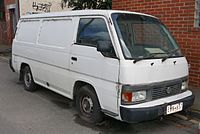 Nissan Urvan Cargo SWB (E24)
Nissan Urvan Cargo SWB (E24)
-
 Nissan Urvan Cargo SWB (E24)
Nissan Urvan Cargo SWB (E24)
Fourth generation (E25; 2001)
Motor vehicle| Caravan (E25) | |
|---|---|
 Nissan Caravan 3.0 Di with dual sliding door (pre-facelift) Nissan Caravan 3.0 Di with dual sliding door (pre-facelift) | |
| Overview | |
| Also called | Nissan Urvan Nissan Urvan Estate Isuzu Como |
| Production | April 2001 – May 2012 April 2002 – March 2014 (Philippines) |
| Assembly | Japan: Kanagawa (Nissan Shatai) Angola: Luanda (Zhongji Company) Malaysia: Kuala Lumpur (TCMA) Philippines: Santa Rosa City (UMC) |
| Powertrain | |
| Engine | |
| Transmission | 5-speed manual 4-speed automatic |
| Dimensions | |
| Wheelbase | 2,715 mm (106.9 in) |
| Length | Pre-facelift: 4,990 mm (196.5 in) Facelift: 4,995 mm (196.7 in) |
| Width | 1,690 mm (66.5 in) |
| Height | 1,990 mm (78.3 in) 2,285 mm (90.0 in) |
| Curb weight | 1,670 kg (3,682 lb) |
| Chronology | |
| Successor | Nissan NV (Mexico) Nissan NV350 Caravan (Japan) |
Nissan produced the E25 series from April 2001 to 2012. It was also sold as the Isuzu Como on the Japanese market, replacing the last generation Isuzu Fargo which was a rebadged version of the E24 Caravan. The New Zealand Urvan received a one-star rating on the ANCAP crash test.
Mexico was the only North American country to receive the Nissan Caravan vans. 2010 was the last year for this generation in Mexico, as the US-built Nissan NV replaces it.
-
 Nissan Caravan 3.0 Di with dual sliding door (pre-facelift)
Nissan Caravan 3.0 Di with dual sliding door (pre-facelift)
-
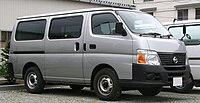 Nissan Caravan 3.0 Di with dual sliding door (facelift)
Nissan Caravan 3.0 Di with dual sliding door (facelift)
-
 Nissan Caravan High Roof with single sliding door (facelift)
Nissan Caravan High Roof with single sliding door (facelift)
-
 Nissan Caravan High Roof with single sliding door (facelift)
Nissan Caravan High Roof with single sliding door (facelift)
-
 Nissan Urvan Thai version (facelift)
Nissan Urvan Thai version (facelift)
-
 Isuzu Como Minibus LS with single sliding door (pre-facelift)
Isuzu Como Minibus LS with single sliding door (pre-facelift)
-
 Isuzu Como LD Panel Van with dual sliding door (facelift)
Isuzu Como LD Panel Van with dual sliding door (facelift)
Fifth generation (E26; 2012)
Motor vehicle| NV350 Caravan (E26) | |
|---|---|
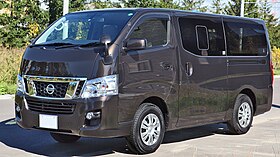 Nissan NV350 Caravan Premium GX (pre-facelift) Nissan NV350 Caravan Premium GX (pre-facelift) | |
| Overview | |
| Also called | Nissan NV350 Urvan Nissan NV350 Impendulo Isuzu Como Mitsubishi Fuso Canter Van Nissan NV350 Panel Van Nissan Paramedic |
| Production | June 2012 – present |
| Assembly | Japan: Kanda, Fukuoka, Kyushu (Nissan Shatai) Thailand: Samut Prakan (NMT) |
| Powertrain | |
| Engine | |
| Transmission |
|
| Dimensions | |
| Wheelbase | SWB: 2,555 mm (100.6 in) LWB: 2,940 mm (115.7 in) |
| Length | SWB: 4,695 mm (184.8 in) LWB: 5,080 mm (200.0 in) |
| Width | 1,695 mm (66.7 in) 1,880 mm (74.0 in) (wide body) |
| Height | Low roof: 1,990 mm (78.3 in) High roof: 2,285 mm (90.0 in) |
| Chronology | |
| Predecessor | Nissan Paramedic (E50) Nissan NV (North America) |
At the 2011 Tokyo Motor Show, a replacement of the Nissan Caravan, called the NV350 Caravan, was premiered. It went on sale on 15 June 2012 with diesel engine and super long body variants went on sale on 13 July 2012, and the wide version model arrived in winter 2012. The new NV350 Caravan comes with the all new YD25DDTi engine with clean diesel technology. Most petrol engines take advantage of its fuel saving technology for class leading fuel economy, for example the QR20DE. Those engines achieved either a 10 or 5 percent improvement in fuel economy over Japan's 2015 fuel economy standard. The NV350 Caravan continues to be sold as the Isuzu Como on the Japanese market as well. The NV350 Caravan received its first facelift on 13 July 2017 and its second facelift on 20 October 2021, when it was renamed back to Nissan Caravan.
In the Philippines, the NV350 Caravan (E26) was introduced on 11 June 2015 and is known as the NV350 Urvan. The NV350 Urvan is imported from Japan rather than being assembled locally. It is offered in five models: the base-grade 3-seater Cargo, the base-line 15-seater and 18-seater Standard, the mid-range 12-seater, and the high-end 10-seater Super Elite. In May 2017, the base-top-of-the-line Premium was launched. It is a 15-seater model, available with 5-speed manual and 5-speed automatic transmissions, being the first ever Urvan in the Philippines that comes with a standard automatic transmission. In March 2018, the high-top-of-the-line 8-seater Premium S was launched, it is also offered with either a 5-speed manual or an automatic transmission.
On 11 September 2013, Mitsubishi Fuso Truck and Bus Corporation and Nissan Motor Co., Ltd reached a basic agreement regarding original equipment manufacturer supply of finished commercial vans for export, whereby Nissan would supply NV350 Urvans to be sold as the Fuso Canter Van in the Middle East from 2014. Two versions are offered, the van and microbus.
The E26 is sold in Mexico as the NV350 Urvan.
2022 facelift
The second facelift Caravan was launched for the Japanese market on 20 October 2021. It features the new flat-bottom steering wheel, while the layout of the dashboard remains the same. High-trim variants also get automatic climate control, a touchscreen infotainment system, and copper accents on the air-conditioning vents. The second facelift Caravan also comes with the latest version of the Nissan Intelligent Mobility safety suite of technology. As a result, lane departure warning, intelligent emergency brake, and intelligent around-view monitor are just some of the features that come standard on the second facelift Caravan.
Subsequent to the OEM deal with Mitsubishi, Nissan also added Mitsubishi's 4N16 diesel engine at the time of the facelift. This was coupled to a new, 7-speed automatic transmission.
In the Philippines, the facelifted Caravan was introduced on 24 October 2022 as the Urvan. It is offered in five grades: the entry-level 3-seater Cargo (Hi-roof), the mid-grade 15-seater and 18-seater Standard (Normal roof), the high-end 3-seater GX (Hi-roof), and the top-spec 15-seater Premium (Hi-roof). 12-seater, Super Elite and Premium S grades were removed from the lineup. For the Philippine market, the Urvan retains the YD25DDTi diesel engine mated to a 5-speed manual transmission for all models and 5-speed automatic transmission which is only available for the GX and Premium grades.
Gallery
-
Nissan NV350 Caravan Microbus GX (pre-facelift)
-
 Nissan NV350 Urvan (pre-facelift)
Nissan NV350 Urvan (pre-facelift)
-
 Nissan NV350 Caravan Premium GX (pre-facelift)
Nissan NV350 Caravan Premium GX (pre-facelift)
-
 Nissan NV350 Caravan DX with single sliding door (first facelift)
Nissan NV350 Caravan DX with single sliding door (first facelift)
-
 Nissan NV350 Caravan DX with dual sliding door (first facelift)
Nissan NV350 Caravan DX with dual sliding door (first facelift)
-
 Nissan NV350 Caravan Premium GX (first facelift)
Nissan NV350 Caravan Premium GX (first facelift)
-
 Nissan NV350 Caravan Premium GX (first facelift)
Nissan NV350 Caravan Premium GX (first facelift)
-
 Nissan Caravan EX (second facelift)
Nissan Caravan EX (second facelift)
-
 Nissan Caravan EX (second facelift)
Nissan Caravan EX (second facelift)
-
 Nissan Caravan Grand Premium GX (second facelift)
Nissan Caravan Grand Premium GX (second facelift)
-
 Nissan Caravan Autech (second facelift)
Nissan Caravan Autech (second facelift)
-
 Interior (DX; first facelift)
Interior (DX; first facelift)
-
 Interior (Premium GX; pre-facelift)
Interior (Premium GX; pre-facelift)
-
 Interior (Transporter; first facelift)
Interior (Transporter; first facelift)
-
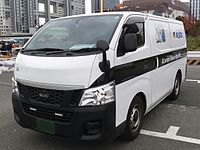 2014 Isuzu Como
2014 Isuzu Como
References
- Carpaydiem. "Nissan Caravan Popular Models, Specs, and Comparison!". Carused.jp. Retrieved 30 June 2020.
- "1966 Datsun Homer". Early Datsun. Archived from the original on 11 August 2010. Retrieved 28 January 2017.
- "Nissan Junior Caball C40". Early Datsun. Retrieved 28 January 2017.
- "Nissan Caravan: specs and photos E20Long minibus 4 door 1.6 MT". Car Model Spec.com. carmodelspec.com. Archived from the original on 2 February 2017. Retrieved 29 January 2017.
- Business Japan, Volume 35, Issues 1-6, page 21.
- de Feijter, Tycho (31 October 2017). "Spotted In China: FAW Jiefang CA5020XJH ex-Ambulance". ChinaCarHistory. Retrieved 27 March 2022.
- ^ Car Graphic: Car Archives Vol. 11, '80s Japanese Cars (in Japanese). Tokyo: Nigensha. 2007. p. 141. ISBN 978-4-544-91018-6.
- Hermoso, Tito (24 September 2012). "R.I.P. Made in R.P." AutoIndustriya.com. Philippines: AutoIndustriya. Retrieved 26 October 2022.
- 博瑞祥云奥迪 (9 August 2017). "80年代国内日本中型面包车一览-新浪汽车". Sina Corp. Retrieved 27 March 2022.
- "90年代回忆之我们一起追过的轻客 - 二手车趣闻-第一车网". Archived from the original on 14 May 2019. Retrieved 14 May 2019.
- Wang Che (16 May 2001). "可通行长安街的旅行车和轻型越野车列表" [List of station wagons and light off-road vehicles allowed on Chang'an Avenue]. auto-sina. SINA.com. Archived from the original on 14 May 2019.
- "Nissan Urvan (E25)". Australasian New Car Assessment Program. Archived from the original on 2 June 2014.
- Gluckman, David (10 March 2010). "2011 Nissan NV1500 / NV2500 HD / NV3500 HD – Car News". Car and Driver. Retrieved 7 April 2016.
- https://markwhitenissantoti.co.za/wp-content/uploads/2018/06/taxi-brochure-may2016-web-version.pdf
- ^ "2022 Nissan Urvan is getting Mitsubishi 2.4L diesel". AutoIndustriya.com. 2 March 2022. Archived from the original on 6 December 2022.
- "Nissan Releases All-New NV350 Caravan" (Press release). Nissan. 15 June 2012. Archived from the original on 6 April 2016. Retrieved 7 April 2016.
- "BPI Auto Loans". bpiautoloans.com. Archived from the original on 4 April 2016. Retrieved 11 January 2022.
- "Nissan Philippines Launches Super-sized Urvan Premium (w/ 15 Photos, Specs)". CarGuide.PH. 19 April 2017.
- "The 2018 Nissan Urvan Premium S is Definitely for VIPs (w/ Brochure)". CarGuide.PH. 22 March 2018.
- "NV350 URVAN | Nissan Philippines". Archived from the original on 21 October 2021. Retrieved 21 October 2021.
- "Mitsubishi Fuso and Nissan Agree on Van OEM Supply for Export" (Press release). Nissan. 11 September 2013. Archived from the original on 17 November 2016. Retrieved 7 April 2016.
- https://global.nissannews.com/en/releases/141003-02-e?source=nng
- "Canter Van (van)". Mitsubishi Fuso Truck and Bus Corporation. Archived from the original on 22 January 2015.
- "Canter Van (microbus)". Mitsubishi Fuso Truck and Bus Corporation. Archived from the original on 22 January 2015.
- Altoveros, Jose (20 October 2021). "2022 Nissan Urvan levels up in luxury and design". AutoIndustriya.com. Philippines: AutoIndustriya. Retrieved 21 October 2021.
- "2023 Nissan Urvan quietly rolled out in PH". Top Gear Philippines. 24 October 2022.
- "Nissan PH Adds Safety, Variants To 2023 Urvan Line-Up". CarGuide.PH. 3 November 2022. Retrieved 3 November 2022.
- "Facelifted 2023 Nissan Urvan now available in PH dealerships - Auto News". AutoIndustriya.com. 24 October 2022. Retrieved 24 October 2022.
External links
| Nissan road car timeline, European market, 1980–2019 — next » | |||||||||||||||||||||||||||||||||||||||||||||||||||||||||||||||||||||||||||||||||||||||||||||||||||||||||||||||||||||||||||||||||||||||||||||||||||||||||||||||||||||||||||||||||||||||||||||||||||||||||||||||||||||||||||||||||||||||||||||||||||||||||||||||||||||||||||||||||||||||||||||||||||||||||||||||||||||||||||||||||||||||||||||||||||||||||||||||||||||||||||||||||||||||||||||||||||||||||||||||||||||||||||||||||||||||||||||||||||||||||||||||||||||||||||||||||||||||||||||||||||||||||||||||||||||||||||||||||||||||||||||||||||||||||||||||||||||||||||||||||||||||||||||||||||||||||||||||||||||||||||||||||||||||||||||||||||||||||||||||||||||||||||||||||||||||||||||||||||||||||||||||||||||||||||||||||||||||||||||||||||||||||||||||||||||||||||||||||||||||||||||||||||||||||||||||||||||||||||||||||||||||||||||||||||||||||||||||||||||||||||||||||||||||||||||||||||||||||||||||||||||||||||||||||||||||||||||||||||||||||||||||||||||||||||||||||||||||||||||||||||||||||||||||||||||||||||||||||||||||
|---|---|---|---|---|---|---|---|---|---|---|---|---|---|---|---|---|---|---|---|---|---|---|---|---|---|---|---|---|---|---|---|---|---|---|---|---|---|---|---|---|---|---|---|---|---|---|---|---|---|---|---|---|---|---|---|---|---|---|---|---|---|---|---|---|---|---|---|---|---|---|---|---|---|---|---|---|---|---|---|---|---|---|---|---|---|---|---|---|---|---|---|---|---|---|---|---|---|---|---|---|---|---|---|---|---|---|---|---|---|---|---|---|---|---|---|---|---|---|---|---|---|---|---|---|---|---|---|---|---|---|---|---|---|---|---|---|---|---|---|---|---|---|---|---|---|---|---|---|---|---|---|---|---|---|---|---|---|---|---|---|---|---|---|---|---|---|---|---|---|---|---|---|---|---|---|---|---|---|---|---|---|---|---|---|---|---|---|---|---|---|---|---|---|---|---|---|---|---|---|---|---|---|---|---|---|---|---|---|---|---|---|---|---|---|---|---|---|---|---|---|---|---|---|---|---|---|---|---|---|---|---|---|---|---|---|---|---|---|---|---|---|---|---|---|---|---|---|---|---|---|---|---|---|---|---|---|---|---|---|---|---|---|---|---|---|---|---|---|---|---|---|---|---|---|---|---|---|---|---|---|---|---|---|---|---|---|---|---|---|---|---|---|---|---|---|---|---|---|---|---|---|---|---|---|---|---|---|---|---|---|---|---|---|---|---|---|---|---|---|---|---|---|---|---|---|---|---|---|---|---|---|---|---|---|---|---|---|---|---|---|---|---|---|---|---|---|---|---|---|---|---|---|---|---|---|---|---|---|---|---|---|---|---|---|---|---|---|---|---|---|---|---|---|---|---|---|---|---|---|---|---|---|---|---|---|---|---|---|---|---|---|---|---|---|---|---|---|---|---|---|---|---|---|---|---|---|---|---|---|---|---|---|---|---|---|---|---|---|---|---|---|---|---|---|---|---|---|---|---|---|---|---|---|---|---|---|---|---|---|---|---|---|---|---|---|---|---|---|---|---|---|---|---|---|---|---|---|---|---|---|---|---|---|---|---|---|---|---|---|---|---|---|---|---|---|---|---|---|---|---|---|---|---|---|---|---|---|---|---|---|---|---|---|---|---|---|---|---|---|---|---|---|---|---|---|---|---|---|---|---|---|---|---|---|---|---|---|---|---|---|---|---|---|---|---|---|---|---|---|---|---|---|---|---|---|---|---|---|---|---|---|---|---|---|---|---|---|---|---|---|---|---|---|---|---|---|---|---|---|---|---|---|---|---|---|---|---|---|---|---|---|---|---|---|---|---|---|---|---|---|---|---|---|---|---|---|---|---|---|---|---|---|---|---|---|---|---|---|---|---|---|---|---|---|---|---|---|---|---|---|---|---|---|---|---|---|---|---|---|---|---|---|---|---|---|---|---|---|---|---|---|---|---|---|---|---|---|---|---|---|---|---|---|---|---|---|---|---|---|---|---|---|---|---|---|---|---|---|---|---|---|---|---|---|---|---|---|---|---|---|---|---|---|---|---|---|---|---|---|---|---|---|---|---|---|---|---|---|---|---|---|---|---|---|---|---|---|---|---|---|---|---|---|---|---|---|---|---|---|---|---|---|---|---|---|---|---|---|---|---|---|---|---|---|---|---|---|---|---|---|---|---|---|---|---|---|---|---|---|---|---|---|---|---|---|---|---|---|---|---|---|---|---|---|---|---|---|---|---|---|---|---|---|---|---|---|---|---|---|---|---|---|---|---|---|---|---|---|---|---|---|---|---|---|---|---|---|---|---|---|---|---|---|---|---|---|---|---|---|---|---|---|---|---|---|---|---|---|---|---|---|---|---|---|---|---|---|---|---|---|---|---|---|---|---|---|---|---|---|---|---|---|---|---|---|---|---|---|---|---|---|---|---|---|---|---|---|---|---|---|---|---|---|---|---|---|---|---|---|---|---|---|---|---|---|---|---|---|---|---|---|---|---|---|---|---|---|---|---|---|---|---|---|---|---|---|---|---|---|---|---|---|---|---|---|---|---|---|---|---|---|---|---|---|---|---|---|---|---|---|---|---|---|---|---|---|---|---|---|---|---|---|---|---|---|---|---|---|---|---|---|---|---|---|---|---|---|---|---|---|---|---|---|---|---|---|---|---|---|---|---|---|---|---|---|---|---|---|---|---|---|---|---|---|---|---|---|---|---|---|---|---|---|---|---|---|---|---|---|---|---|---|---|---|---|---|---|---|---|---|---|---|---|---|---|---|---|---|---|
| |||||||||||||||||||||||||||||||||||||||||||||||||||||||||||||||||||||||||||||||||||||||||||||||||||||||||||||||||||||||||||||||||||||||||||||||||||||||||||||||||||||||||||||||||||||||||||||||||||||||||||||||||||||||||||||||||||||||||||||||||||||||||||||||||||||||||||||||||||||||||||||||||||||||||||||||||||||||||||||||||||||||||||||||||||||||||||||||||||||||||||||||||||||||||||||||||||||||||||||||||||||||||||||||||||||||||||||||||||||||||||||||||||||||||||||||||||||||||||||||||||||||||||||||||||||||||||||||||||||||||||||||||||||||||||||||||||||||||||||||||||||||||||||||||||||||||||||||||||||||||||||||||||||||||||||||||||||||||||||||||||||||||||||||||||||||||||||||||||||||||||||||||||||||||||||||||||||||||||||||||||||||||||||||||||||||||||||||||||||||||||||||||||||||||||||||||||||||||||||||||||||||||||||||||||||||||||||||||||||||||||||||||||||||||||||||||||||||||||||||||||||||||||||||||||||||||||||||||||||||||||||||||||||||||||||||||||||||||||||||||||||||||||||||||||||||||||||||||||||||
| « previous — Isuzu international road car timeline, 1980s–present | |||||||||||||||||||||||||||||||||||||||||||||||||||||||||||||||||||||||||||||||||||||||||||||||||||||||||||||||||||||||||||||||||||||||||||||||||||||||||||||||||||||||||||||||||||||||||||||||||||||||||||||||||||||||||||||||||||||||||||||||||||||||||||||||||||||||||||||||||||||||||||||||||||||||||||||||||||||||||||||||||||||||||||||||||||||||||||||||||||||||||||||||||||||||||||||||||||||||||||||||||||||||||||||||||||||||||||||||||||||||||||||||||||||||||||||||||||||||||||||||||||||||||||||||||||||||||||||||||||||||||||||||||||||||||||||||||||||||||||||||||||||||||||||||||||||||||||||||||||||||||||||||||||||||||||||||||||||||||||||||||||||||||||||||||||||||||||||||||||||||||||||||||||||||||||||||||||||||||||||||||||||||||||||||||||||||||||||||||||||||||||||||||||||||||||||||||||||||||||||||||||||||||||||||||||||||||||||||||||||||||||||||||||||||||||||||||||||||||||||||||||||||||||||||||||||||||||||||||||||||||||||||
|---|---|---|---|---|---|---|---|---|---|---|---|---|---|---|---|---|---|---|---|---|---|---|---|---|---|---|---|---|---|---|---|---|---|---|---|---|---|---|---|---|---|---|---|---|---|---|---|---|---|---|---|---|---|---|---|---|---|---|---|---|---|---|---|---|---|---|---|---|---|---|---|---|---|---|---|---|---|---|---|---|---|---|---|---|---|---|---|---|---|---|---|---|---|---|---|---|---|---|---|---|---|---|---|---|---|---|---|---|---|---|---|---|---|---|---|---|---|---|---|---|---|---|---|---|---|---|---|---|---|---|---|---|---|---|---|---|---|---|---|---|---|---|---|---|---|---|---|---|---|---|---|---|---|---|---|---|---|---|---|---|---|---|---|---|---|---|---|---|---|---|---|---|---|---|---|---|---|---|---|---|---|---|---|---|---|---|---|---|---|---|---|---|---|---|---|---|---|---|---|---|---|---|---|---|---|---|---|---|---|---|---|---|---|---|---|---|---|---|---|---|---|---|---|---|---|---|---|---|---|---|---|---|---|---|---|---|---|---|---|---|---|---|---|---|---|---|---|---|---|---|---|---|---|---|---|---|---|---|---|---|---|---|---|---|---|---|---|---|---|---|---|---|---|---|---|---|---|---|---|---|---|---|---|---|---|---|---|---|---|---|---|---|---|---|---|---|---|---|---|---|---|---|---|---|---|---|---|---|---|---|---|---|---|---|---|---|---|---|---|---|---|---|---|---|---|---|---|---|---|---|---|---|---|---|---|---|---|---|---|---|---|---|---|---|---|---|---|---|---|---|---|---|---|---|---|---|---|---|---|---|---|---|---|---|---|---|---|---|---|---|---|---|---|---|---|---|---|---|---|---|---|---|---|---|---|---|---|---|---|---|---|---|---|---|---|---|---|---|---|---|---|---|---|---|---|---|---|---|---|---|---|---|---|---|---|---|---|---|---|---|---|---|---|---|---|---|---|---|---|---|---|---|---|---|---|---|---|---|---|---|---|---|---|---|---|---|---|---|---|---|---|---|---|---|---|---|---|---|---|---|---|---|---|---|---|---|---|---|---|---|---|---|---|---|---|---|---|---|---|---|---|---|---|---|---|---|---|---|---|---|---|---|---|---|---|---|---|---|---|---|---|---|---|---|---|---|---|---|---|---|---|---|---|---|---|---|---|---|---|---|---|---|---|---|---|---|---|---|---|---|---|---|---|---|---|---|---|---|---|---|---|---|---|---|---|---|---|---|---|---|---|---|---|---|---|---|---|---|---|---|---|---|---|---|---|---|---|---|---|---|---|---|---|---|---|---|---|---|---|---|---|---|---|---|---|---|---|---|---|---|---|---|---|---|---|---|---|---|---|---|---|---|---|---|---|---|---|---|---|---|---|---|---|---|---|---|---|---|---|---|---|---|---|---|---|---|---|---|---|---|---|---|---|---|---|---|---|---|---|---|---|---|---|---|---|---|---|---|---|---|---|---|---|---|---|---|---|---|---|---|---|---|---|---|---|---|---|---|---|---|---|---|---|---|---|---|---|---|---|---|---|---|---|---|---|---|---|---|---|---|---|---|---|---|---|---|---|---|---|---|---|---|---|---|---|---|---|---|---|---|---|---|---|---|---|---|---|---|---|---|---|---|---|---|---|---|---|---|---|---|---|---|---|---|---|---|---|---|---|---|---|---|---|---|---|---|---|---|---|---|---|---|---|---|---|---|---|---|---|---|---|---|---|---|---|---|---|---|---|---|---|---|---|---|---|---|---|---|---|---|---|---|---|---|---|---|---|---|---|---|---|---|---|---|---|---|---|---|---|---|---|---|---|---|---|---|---|---|---|---|---|---|---|---|---|---|---|---|---|---|---|---|---|---|---|---|---|---|---|---|---|---|---|---|---|---|---|---|---|---|---|---|---|---|---|---|---|---|---|---|---|---|---|---|---|---|---|---|---|---|---|---|---|---|---|---|---|---|---|---|---|---|---|---|---|---|---|---|---|---|---|---|---|---|---|---|---|---|---|---|---|---|---|---|---|---|---|---|---|---|---|---|---|---|---|---|---|---|---|---|---|---|---|---|---|---|---|---|---|---|---|---|---|---|---|---|---|
| |||||||||||||||||||||||||||||||||||||||||||||||||||||||||||||||||||||||||||||||||||||||||||||||||||||||||||||||||||||||||||||||||||||||||||||||||||||||||||||||||||||||||||||||||||||||||||||||||||||||||||||||||||||||||||||||||||||||||||||||||||||||||||||||||||||||||||||||||||||||||||||||||||||||||||||||||||||||||||||||||||||||||||||||||||||||||||||||||||||||||||||||||||||||||||||||||||||||||||||||||||||||||||||||||||||||||||||||||||||||||||||||||||||||||||||||||||||||||||||||||||||||||||||||||||||||||||||||||||||||||||||||||||||||||||||||||||||||||||||||||||||||||||||||||||||||||||||||||||||||||||||||||||||||||||||||||||||||||||||||||||||||||||||||||||||||||||||||||||||||||||||||||||||||||||||||||||||||||||||||||||||||||||||||||||||||||||||||||||||||||||||||||||||||||||||||||||||||||||||||||||||||||||||||||||||||||||||||||||||||||||||||||||||||||||||||||||||||||||||||||||||||||||||||||||||||||||||||||||||||||||||||